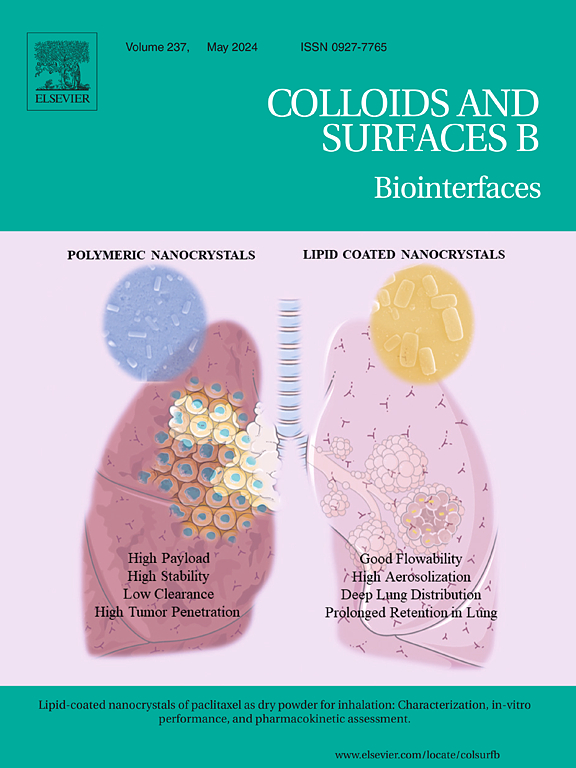The role of sialic acid and macromolecular depletion interactions in red blood cell adhesion: Insights from interference reflection microscopy
IF 5.4
2区 医学
Q1 BIOPHYSICS
引用次数: 0
Abstract
Red blood cell (RBC) adhesion plays a pivotal role in vascular physiology and has been implicated in various pathological conditions, including diabetes and hypertension. This study aims to elucidate the interplay between sialic acid removal and macromolecular depletion interactions on RBC adhesion using interference reflection microscopy (IRM). The adhesion of RBC to surfaces coated with albumin in the presence of polymers is quantitatively assessed, focusing on how neuraminidase-induced desialylation influences adhesion dynamics. Our findings demonstrate that sialic acid removal significantly enhances RBC adhesion in solutions containing high-molecular-weight dextran, while at the same time, membrane undulations were reduced. No significant increase in the adhesion energies was observed without the presence of polymers. However, in the presence of the depleted polymer, the adhesion energy correlates positively with neuraminidase concentration. This indicates a substantial increase in depletion interaction energy due to the altered cell surface properties and suggests that macromolecular depletion forces might contribute to abnormal RBC adhesion in pathologies associated with reduced surface charge, providing new insights into the biophysical mechanisms of RBC adhesion in health and disease.
唾液酸和大分子耗竭相互作用在红细胞粘附中的作用:来自干涉反射显微镜的见解
红细胞(RBC)粘附在血管生理学中起着关键作用,并与多种病理状况有关,包括糖尿病和高血压。本研究旨在利用干涉反射显微镜(IRM)研究唾液酸去除和大分子耗竭对红细胞粘附的相互作用。在聚合物存在的情况下,红细胞对白蛋白涂层表面的粘附进行了定量评估,重点关注神经氨酸酶诱导的脱氮化如何影响粘附动力学。我们的研究结果表明,在含有高分子量葡聚糖的溶液中,唾液酸的去除显著增强了红细胞的粘附性,同时减少了膜的波动。在没有聚合物存在的情况下,没有观察到粘附能的显著增加。然而,在耗尽聚合物的存在下,粘附能与神经氨酸酶浓度呈正相关。这表明,由于细胞表面特性的改变,耗竭相互作用能大幅增加,并表明大分子耗竭力可能导致与表面电荷减少相关的病理中红细胞异常粘附,为健康和疾病中红细胞粘附的生物物理机制提供了新的见解。
本文章由计算机程序翻译,如有差异,请以英文原文为准。
求助全文
约1分钟内获得全文
求助全文
来源期刊

Colloids and Surfaces B: Biointerfaces
生物-材料科学:生物材料
CiteScore
11.10
自引率
3.40%
发文量
730
审稿时长
42 days
期刊介绍:
Colloids and Surfaces B: Biointerfaces is an international journal devoted to fundamental and applied research on colloid and interfacial phenomena in relation to systems of biological origin, having particular relevance to the medical, pharmaceutical, biotechnological, food and cosmetic fields.
Submissions that: (1) deal solely with biological phenomena and do not describe the physico-chemical or colloid-chemical background and/or mechanism of the phenomena, and (2) deal solely with colloid/interfacial phenomena and do not have appropriate biological content or relevance, are outside the scope of the journal and will not be considered for publication.
The journal publishes regular research papers, reviews, short communications and invited perspective articles, called BioInterface Perspectives. The BioInterface Perspective provide researchers the opportunity to review their own work, as well as provide insight into the work of others that inspired and influenced the author. Regular articles should have a maximum total length of 6,000 words. In addition, a (combined) maximum of 8 normal-sized figures and/or tables is allowed (so for instance 3 tables and 5 figures). For multiple-panel figures each set of two panels equates to one figure. Short communications should not exceed half of the above. It is required to give on the article cover page a short statistical summary of the article listing the total number of words and tables/figures.
 求助内容:
求助内容: 应助结果提醒方式:
应助结果提醒方式:


